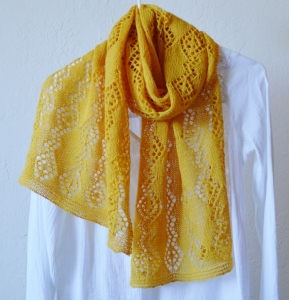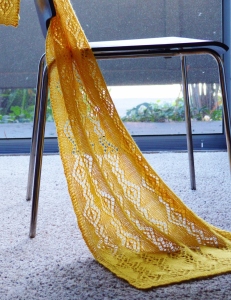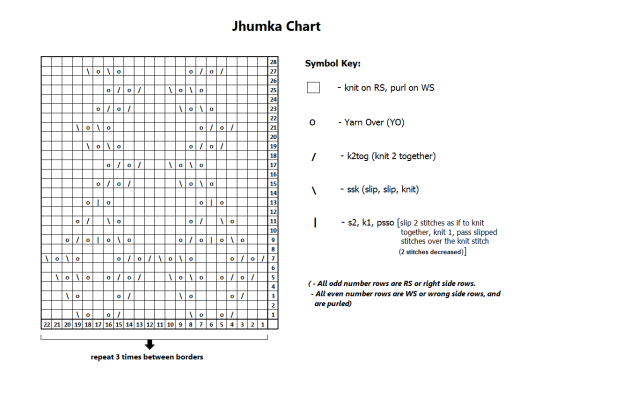Download PDF version o the pattern here: Jhumka PDF (to download and print)
Jhumka, which means earring (dangler) in Hindi / Urdu, is a rectangular shawl featuring a lace pattern worked over a multiple of 22 stitches and 28 rows. You cast on a total of 74 stitches, including 66 main pattern stitches (22 x 3) in the center and 8 border stitches – 4 on either side. The shawl can be made wider or narrower, longer or shorter by adding or leaving out one or more pattern repeats.
The pattern includes both a chart and written instructions.
Yarn
– I used approx. 2 skeins or 550 yards of the Cascade 220 Fingering in the Goldenrod colorway.
Needles
– A pair of US size 6 (4 mm) needles for knitting
– US size 8 (5 mm) needle for casting on loosely (optional)
Notions:
– 2-4 Stitch markers (if using)
– Blocking pins / wires
– Tapestry needle to weave in ends
Gauge (after blocking)
– 20.5 stitches and 27 rows = 4 inches, measured over the Jhumka lace pattern
Finished dimensions
– 14.5 inches wide and 61 inches long
Abbreviations:
- RS – Right side
- WS – Wrong side
- YO – yarn over
- k2tog – Knit 2 together
- ssk – slip, slip, knit the 2 slipped stitches together
- (s2, k1, psso) – slip two stitches together as if to knit; knit 1 stitch; pass slipped stitches over the knit stitch (2 stitches decreased)
Jhumka stitch pattern (worked over multiples of 22 stitches and 28 rows):
(Note: Rows 1- 14, that make up the diamonds in the pattern, can be further broken down into smaller 11- stitch repeats, but I have not done that and have written all rows as 22-stitch repeats to maintain consistency. Please refer to the chart for more clarity.)
- Row 1 (RS) – *k3, k2tog, YO, k1, YO, ssk, k6, k2tog, YO, k1, YO, ssk, k3*, repeat from * to * for pattern
- Row 2 (WS) and all WS rows – purl all stitches
- Row 3 – *k2, k2tog, YO, K3, YO, ssk, k4, k2tog, YO, k3, YO, ssk, k2*, repeat from * to *
- Row 5 – *k1, (k2tog, YO) twice, k1, (YO, ssk) twice, k2, (k2tog, YO) twice, k1, (YO, ssk) twice, k1*, repeat from * to *
- Row 7 – *[(k2tog, YO) twice, k3, (YO, ssk) twice] repeat twice *, repeat from * to *
- Row 9 – *k2, YO, ssk, YO, (s2, k1, psso), YO, k2tog, YO, k4, YO, ssk, YO, (s2, k1, psso), YO, k2tog, YO, k2 *, repeat from * to *
- Row 11 – *k3, YO, ssk, k1, k2tog, YO, k6, YO, ssk, k1, k2tog, YO, k3*, repeat from * to *
- Row 13 – *k4, YO, (s2, k1, psso), YO, k8, YO, (s2, k1, psso), YO, k4*, repeat from * to *
- Row 15 – *k5, (YO, ssk) twice, k4, (k2tog, YO) twice, k5*, repeat from * to *
- Row 17 – *k6, (YO, ssk) twice, k2, (k2tog, YO) twice, k6*, repeat from * to *
- Row 19 – *k4, (k2tog, YO) twice, k6, (YO, ssk) twice. k4*, repeat from * to *
- Row 21 – *k3, (k2tog, YO) twice, k8, (YO, ssk) twice, k3*, repeat from * to *
- Row 23 – same as row 15
- Row 25 – same as row 17
- Row 27 – same as row 19
- Row 28 (WS) – purl all stitches
Repeat rows 1 to 28 for pattern
Pattern Instructions:
- Loosely cast on 74 stitches using the larger needle (if using). I used the long-tail method to cast on.
- Switch to smaller needles. Knit 7 rows.
- On row 8 (WS), knit 4 stitches, purl 66 stitches, knit the last 4 stitches.
From this point on, the first and last 4 stitches will always be knit to form a garter stitch border, and the Jhumka stitch pattern will be worked over the center 66 stitches (22 x 3).
Stole body:
- On row 9 (RS), knit 4 stitches; work row 1 of the Jhumka chart /stitch pattern 3 times (placing stitch markers between every repeat if you want); knit the last 4 stitches.
- On the next row (WS), knit 4 stitches; purl 66; knit the last 4 stitches (all WS rows are worked this way).
- Continue, as above, to knit rows 3 to 28 of the Jhumka pattern, maintaining a garter stitch border throughout.
Repeat rows 1 to 28 of the Jhumka stitch pattern a total of 14 times. Then knit rows 1 – 14 of the pattern once more (ending with row 14 – a WS row).
(You can work fewer or more repeats of the pattern to make the stole shorter or longer. Just remember to end with row 14.)
To finish:
- Knit 7 rows
- Loosely bind off all stitches knitwise (on the WS).
- Block to desired measurements. Weave in ends.



Sandhya I just love all your designs and more so the fact that you have named all of them in Hindi . Love love love
Thanks so much, Niaa! 😀
I am having trouble with the Swatch Love that is the green scarf. I cannot seem to get row 1 in the Stitch Pattern to come out right. I do end up having 15 stitches between each marker, but I end up with too many stiches at the end of the row. When counting the stitches of the pattern for the first row, I am actually using 16 stitches, not 15. What am I doing wrong???
Hi Kathy,
I’m guessing you’re referring to the pattern for “Chaukor”. Not sure what you could be doing wrong. Perhaps you could check if you’re working the yarn-overs, ssk and k2tog as written in the pattern, and balancing your increases and decreases? On row one, there’s a yarn over followed by an ssk at stitches 2 and 3, and then a k2tog followed by a yarn over at stitches 13 and 14. You should be ending up with 15 stitches in the end. Hope this helps! Happy knitting 🙂
Truly works of art and balance. I appreciate your great talent.
Thank you so much! 🙂 🙂 🙂
Thank you Sandhya for your beautiful designs. Their beauty is in their simplicity, clarity and Rajasthan inspired creativity. In India we don’t have access to the yarns you have used. We mostly get acrylic yarns from baby to worsted weights. Would acrylic yarns work well? Would appreciate any suggestions.
Thanks again.
Renu
Thanks a ton, Renu! I’m so glad you like the patterns 🙂
I haven’t tried knitting lace with acrylic yarn, but I’m sure you can. It’ll just be a little bit trickier to block acrylic compared to wool, which responds beautifully to wet blocking. I think acrylic needs to be steam blocked, and because these are all lace shawls, blocking is an essential step – the shawl isn’t finished until it’s blocked! So I’d say knit one, and try steam blocking it to stretch out the lace. Or maybe knit a swatch first to test it out? Steam blocking is supposed ‘kill’ the acrylic fabric though, which isn’t necessarily a bad thing – the shawl will retain the shape you block it to permanently and won’t ever spring back to it its original form.
Here are a couple of blog posts that may be useful:
https://www.sheeptoshawl.com/charity/archives/2006/11/entry_222.html
http://www.craftsy.com/blog/2013/05/blocking-knitting-tutorial/
I wish I could tell you more! I need to experiment with acrylic myself.
Are you a Ravelry member? Please join it if you’re not! The South Asian group members there knit beautiful acrylic lace shawls all the time, and are always happy to share information.
Oh and about the yarn weight – these patterns will work with any light yarn. The baby weight should be fine, I think. And because these are just rectangular stoles, you don’t need to worry about getting the right fit!
The knitting needles in India use the UK needle size standards. Here’s a link to a US-UK needle comparison chart –
http://www.woolwarehouse.co.uk/needle-size-yarn-weight-information
Hope that helps!
Happy knitting 🙂
Fantastic Post
Thank you so much! 🙂
Where’s do you buy this yarni in-this color?
Hi Donna,
It’s Cascade 220 Fingering yarn. If you’re in the US, it’s available at lots of LYSes. You can also order online. I know Webs (https://www.yarn.com/products/cascade-yarns-220-fingering) and Craftsy carry 220 Fingering. The colorway name is Goldenrod.